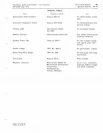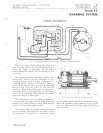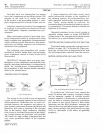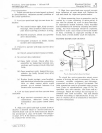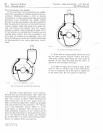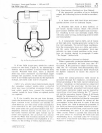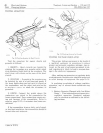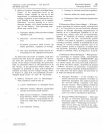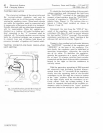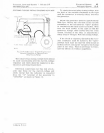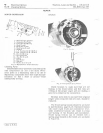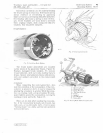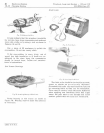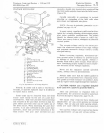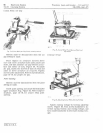
Tractors
,
Lawn
and
Garden
-
110
and
112
Electrical
System
40
SM-2059-(Apr-67)
Charging
System
15-7
2.
Battery
Remains
Charged
with
High
Water
Usage
-
If
the
electrolyte
level
in
the
battery
drops
rapidly
to
the
top
of
the
separators,
it
indicates
that
the
current-
voltage
regulator
is
not
reducing
the
cur-
rent
flowing
to
the
battery
as
it
should
.
Excessive
current
flowing
to
a
full
y
charged
battery
will
cause
serious
dam-
age
in
the
battery.
This
operating
con-
dition
may
result
from:
a.
Improper
setting
of
the
current-voltage
regulator
ill1it.
b.
Defective
current-voltage
regulator
unit.
c.
Grounded
generator
field
circuit
(in
either
generator,
regulator
or
wiring).
d.
The
load
and
battery
leads
may
be
in-
terchanged
at
the
regulator
terminals.
To
determine
the
cause
of
trouble,
first
dis-
connect
the
lead
from
the
regulator
'F"
termi-
t
nal
with
the
generator
operating
at
medium
speed
.
If
the
output
remains
high,
the
generator
field
is
grounded
either
in
the
generator
or
in
the
wiring.
If
the
generator
output
stops,
the
regulator
is
probably
at
fault,
and
it
should
be
checked
for
high
current-voltage
setting.
Refer
to
Figure
4,
page
5-4,
for
possibility
of
inter-
changed
leads
at
the
"L"
and
"B"
terminals.
3.
Battery
Remains
Low
or
Discharged
-
This
condition
could
be
due
to:
a.
Loos
e
connections
or
damaged
wires.
b.
Defective
battery
(Battery
should
take
charge
and
should
crank
engine).
c.
High
circuit
reSistance.
(Check
voltage
drop
between
"BAT"
terminal
of
regu-
lator
and
battery.
Drop
should
not
ex-
ceed
0.15
volts
with
3-4
amperes
flow-
ing.)
d.
Low
regulator
s e
tting.
e.
Damage
or
defects
within
the
regulator.
f.
Defects
within
the
motor-generator.
g.
Continuous
loads
in
excess
of
generator
capacity.
If
Generator
Shows
Some
Output
-
With
gen-
erator
operating
at
medium
speed
, a
charge
rate
of 1
to
3
amperes
is
normal
with
fully
charged
battery
at
normal
operating
temperatures.
If
battery
is
in a
discharged
condition
or
is
ex-
tremely
hot,
charge
rate
will
be
considerably
higher.
If
condition
of
battery
indicates
that
charge
rate
is
too
low,
momentarily
ground
"FIELD"
terminal
of
regulator.
If
output
shows
a
strong
increase,
trouble
is
probably
due
to
low
setting
of
current-voltage
regulator
unit
or
to
dirty
contact
points
in
regulator.
If
output
does
not
increase,
generator
is
probably
at
fault
and
should
be
checked.
Refer
to
Figures
6, 7,
and
8.
If
Generator
Shows
No
Output
-
With
genera-
tor
operating
at
medium
speed,
momentarily
connect
a
jumper
between
"GENERATOR"
and
"BATTERY"
terminals
of
regulator.
If
genera-
tor
shows
output,
the
relay
is
at
fault.
If
genera-
tor
does
not
Show
output,
momentarily
ground
"FIELD"
terminal
or
generator.
If
generator
now
shows
output,
regulator
is
at
fault.
If
genera-
tor
still
does
not
show
output,
the
generator
is
at
fault
and
should
be
checked.
4.
Damaged
Resistor
-
If
the
resistor
at-
tached
beneath
the
regulator
is
broken
or
otherwise
damaged,
the
contact
points
of
the
current-voltage
regulator
unit
soon
become
burned.
This
condition
results
in
a
low
generator
output.
Whenever
a
re-
sistor
is
replaced
it
will
usually
be
found
necessary
to
clean
the
contact
points
in
order
to
restore
satisfactory
operation.
5.
Damage
Within
the
Regulator
-
This
may
be
due
to
reversed
generator
polarity.
Generator
polarity
must
be
corrected,
as
explained
under"
Polarizing
Generator,
"
page
15-18,
after
any
checks
of
the
regu-
lator
or
generator,
or
after
disconnecting
and
reconn
e
cting
leads.
Litho
in
U.S.A.



